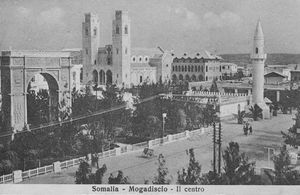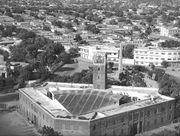Italian Somaliland
|
|||||||||||||||||||||||||||||||||
Italian Somaliland (also known as Italian Somalia; in Italian Somalia italiana) was a colony of the Kingdom of Italy from the 1880s until 1941 in the territory of the modern-day Northeast African nation of Somalia.
Contents |
Somali-Italian treaties and creation of the protectorate
The late 19th century had a huge impact on developments occurring in the Horn of Africa. The European powers (Italy, Great Britain and France) first gained a foothold in Somalia through the signing of various pacts and agreements with the Somali Sultans that then controlled the region, such as Yusuf Ali Kenadid, Boqor Osman Mahamuud and Mohamoud Ali Shire.[1]
In late 1888, Sultan Kenadid entered into a treaty with the Italians, making his Sultanate of Hobyo an Italian protectorate. His rival Boqor Osman was to sign a similar agreement vis-a-vis his own Majeerteen Sultanate the following year. Both rulers had signed the protectorate treaties to advance their own expansionist objectives, with Kenadid looking to use Italy's support in his dispute with the Sultan of Zanzibar over an area bordering Warsheekh, in addition to his ongoing power struggle over the Majeerteen Sultanate with Boqor Osman. Both Sultan Kenadid and his rival Boqor Osman also hoped to exploit the conflicting interests among the European Imperial powers that were then looking to control the Somali peninsula, so as to avoid direct occupation of their territories by force.[2]
The Italians, for their part, were interested in this largely arid country mainly because of its ports, the latter of which could grant them access to the strategically important Suez Canal and the Gulf of Aden.[3] The last piece of land acquired by Italy in Somalia in order to form Italian Somaliland was the Kismayo region (Jubaland), which was earlier controlled by Britain before World War I.[3]
At the end of the 19th century, a growing social-political movement developed within Italy to start expanding its influence, since many other European countries had already been doing so, which was effectively leaving Italy behind. There was also a huge shortage of capital and serious economic problems in Italy.[4] It is also argued by some historians that Italy had a minor interest in the mutton and livestock that were then plentiful in Somalia, though whatever designs Italy may have had on the resource-challenged Somali landscape were undoubtedly subordinate to its interest in the region's ports and the waters and lands they gave access to.[5]
Cesare Correnti organized an expedition under the "Società Geografica Italiana" in 1876. The next year "L’Esploratore" was established by Manfredo Camperio - a travel journal. In 1879 "Società di Esplorazioni Commerciali in Africa" was created, with the Italian Industrial Establishment involved as well. The "Club Africano", which three years later became the "Società Africana D’Italia", was established in Somalia in 1879.
However, in January 1887 Italian troops from Somalia fought a battle against Ras Alula Engida’s militia in Dogali, Eritrea, where they lost 500 troops. The Prime Minister, Agostino Depretis, resigned because of this defeat in July 1887. Prime Minister Francesco Crispi replaced him, and had new plans to create new areas for immigration for Italians.citation needed On May 2, 1889 Menelik II, the Emperor of Ethiopia and Italy signed a peace treaty.
Around 1895 Italy launched the First Italo-Abyssinian War against Ethiopia from its territories in Eritrea and Somalia.
Control of the coast
Italy gained control of the ports of the Benadir coastal area with the concession of a small strip of land on the coast from the Sultan of Zanzibar.[6],[7] and over the following decades, Italian settlement was encouraged. In 1905, Italy assumed the responsibility of creating a colony in southern Somalia, after several failed attempts,[8]following revelations that the Benadir Company had tolerated or collaborated in the perpetuation of the slave trade.[9] The administrative regulator was Governor Mercantelli, with the six subdivisions of Brava, Merca, Lugh, Itala, Bardera, and Jumbo.

In April 5, 1908 the Italian Parliament enacted a basic law to unite all of the parts of southern Somalia into an area called "Somalia Italiana". The colonial power was then divided between the Parliament, the metropolitan government, and the colonial government. The power of the colonial government was the only power that was changed. The civil governor controlled export rights, regulated the rate of exchange, raised or lowered native taxes, and administered all civil services and matters relating to hunting, fishing, and conservation.[10] The governor was in control of the police force, while nominating local residents and military arrangements.[10] Effective Italian control remained largely limited to the coastal areas until the early 1920s.[11] After the collapse of Muhammad Abdullah Hassan’s resistance movement, rebellion and revolt occurred with disputes between different tribes in Northern Somalia. The government of the time again worked together with the old tribesmen in order to try and keep peace between the several tribes, while maintaining close control over the military.[12]
Colonial Development and the early fascist era: 1920 - 1935
In 1920 the Società Agricola Italo-Somala (SAIS) was founded by Prince Luigi Amedeo, Duke of the Abruzzi, in order to explore the agricultural potential of Africa. On December 5, 1923 Fascism came to Somalia with Governor Cesare Maria De Vecchi di Val Cismon. He brought with him forceful ways of colonial rule and ideas.
After World War I the colony in Somalia was extended when Jubaland was acquired from the British colony of Kenya.citation needed In 1923, the fascist governor Cesare Maria De Vecchi started to assume control of the northern Somali lands after the progressive defeats of the then-ruling Somali Sultanates of Obbia and Migiurtinia.citation needed
In 1926, after a bloody repression, southern Somalia was fully pacified and started to enjoy a period of economic development.[13] The Somali colonial troops called Dubats (and the gendarmerie Zaptié) were extensively used by De Vecchi in this military campaign.

In the early 1930s, the new Italian governors, Guido Corni and Maurizio Rava, started a policy of friendly assimilation of the Somalis and their clans. Many Somalis were enrolled in the Italian colonial troops. Some thousands of Italian colonists moved to live in Mogadishu, which became a commercial centre with some small manufacturing companies, and in some agricultural areas around the capital such as the "Villaggio duca degli Abruzzi" (or "Villabruzzi", today Jowhar) and "Genale").[14][15]
In 1920 the Italian explorer and nobleman Luigi Amedeo Savoia-Aosta founded the Villaggio Duca degli Abruzzi as an agricultural settlement in Italian Somaliland, growing bananas, cotton and sugar,[16] and experimenting with new cultivation techniques.citation needed
In 1926, the colony comprised 16 villages, with some 3,000 Somali and 200 Italian inhabitants, and was connected by a 114 km. new railway to Mogadishu. Italian colonial policy followed two principals in Somalia: preservation of the dominant clan and ethnic configurations and respect for Islam as the colony's religion.[17]
Italian East Africa
In October 1935, the southern front of the Second Italo-Abyssinian War was launched into Ethiopia from Italian Somaliland. Italian General Rodolfo Graziani commanded the invasion forces in the south.
In June 1936, after the war ended, Italian Somaliland became part of Italian East Africa. The new colony of the Italian Empire also included Ethiopia and Eritrea and was called Africa Orientale Italiana.
From 1936 to 1940, new roads (like the one called "Imperial Road", from Mogadishu to Addis Abeba) were constructed in the region, as well as new railways (114 km from Mogadishu to Jowhar) and many schools, hospitals, ports, bridges, etc.
In the first half of 1940, there were 22,000 Italians living in Somalia and the colony was one of the most developed in Africa in terms of the standard of living of the colonists and of the Somalis, mainly in the urban areas. More than 10,000 Italians were living in Mogadishu, an administrative capital of the Africa Orientale Italiana, and new buildings were erected in the Italian architectural tradition. By 1940, the Villaggio Duca degli Abruzzi (or "Villabruzzi") had a population of 12,000 people, of whom nearly 3,000 were Italian Somalians, and enjoyed a notable level of development with a small manufacturing area with agricultural industries (sugar mills, etc.).[18]
In the second half of 1940, Italian troops invaded British Somaliland[19] and ejected the British. The Italians also occupied Kenyan areas bordering Jubaland around the villages of Moyale and Buna.[20]
In the spring of 1941 Britain regained control of British Somaliland and conquered Italian Somaliland with the Ogaden, but until the summer of 1943 there was an Italian guerrilla war in all the areas of the former Italian East Africa.
Trust Territory
Italian Somaliland then came under British administration until 1949, when it became a United Nations Trust Territory under Italian administration. This administration lasted ten years, from 1950 to 1960.
In 1960, Italian Somaliland united with the State of Somaliland to form the Republic of Somalia.
Italian governors
- 1908-1910 Tommaso Carletti
- 1910-1916 Giacomo De Martino
- 1916-1919 Giovanni Cherina Ferroni
- 1920-1923 Carlo Ricci
- 1923-1928 Cesare Maria De Vecchi
- 1928-1931 Guido Corni
- 1931-1935 Maurizio Rava
- 1935-1936 Rodolfo Graziani
- 1936-1937 Angelo De Ruben - Ruggiero Santini
- 1937-1939 Francesco Saveno
- 1939-1940 Gustavo Pesenti
- 1940-1941 Carlo De Simone
Gallery
 Mogadiscio in 1936, with the Catholic Cathedral and the Triumphal Arch dedicated to the King of Italy |
 Fiat's Boero Building in Mogadishu (1940) |
 The Parliament Building in Mogadishu, originally built in typical fascist style during the thirties |
 Stamps of 1926 celebrating the union of Jubaland to Italian Somaliland |
 Hotel in the agricultural rural area of "Villaggio Duca degli Abruzzi", built by Duke Luigi Amedeo of Savoia |
 The first cinema opened in Mogadishu |
Notes
- ↑ Mariam Arif Gassem, Somalia: clan vs. nation, (s.n.: 2002), p.4
- ↑ The Majeerteen Sultanates
- ↑ 3.0 3.1 Fitzgerald, Nina J. Somalia (New York: Nova Science, 2002), p 33
- ↑ Tripodi, Paolo. The Colonial Legacy in Somalia. New York: St. Martin's P Inc,, 1999. p 16
- ↑ Tripodi, Paolo. The Colonial Legacy in Somalia, p 12-13
- ↑ Ben-Ghiat, Ruth, Italy and its colonies, in A historical companion to postcolonial literatures: continental Europe and Africa, Poddar, Prem, Patke, Rejeev S. and Jensen, Lars eds., Edinburgh: Edinburgh University Press, 2008, p. 310
- ↑ Olsen, James Stuart and Shadle, Robert, eds., Historical dictionary of European imperialism, Westport, Conn.: 1991, Greenwood Press, p. 567
- ↑ Hess, Robert L. Italian Colonialism in Somalia Chicago: University of Chicago P, 1966. p 101
- ↑ Cassanelli, Lee V. The End of slavery in Africa, Meiers, Suzanne and Roberts, Richard L., eds, University of Wisconsin Press, p. 310
- ↑ 10.0 10.1 Hess, Robert L. Italian Colonialism, p 102
- ↑ Ben-Ghiat, p. 310
- ↑ Hess, Robert L. Italian Colonialism, p 146
- ↑ citation needed
- ↑ Bevilacqua, Piero. Storia dell'emigrazione italiana. p. 233
- ↑ Ben-Ghiat, p. 310
- ↑ Ben-Ghiat, p. 310
- ↑ Ben-Ghiat, p. 311
- ↑ Article with photos on a 2005 visit to 'Villaggio Duca degli Abruzzi' and areas of former Italian Somaliland (in italian)
- ↑ http://books.google.it/books?id=_PwCu_D-HiUC&pg=PT1&lpg=PT1&dq=Mussolini+unleashed+1939-1941&source=web&ots=bmUFdHvwt3&sig=jC3JifKMffvOg6Ss83em2gWtQm4&hl=en&sa=X&oi=book_result&resnum=1&ct=result#PPA154,M1
- ↑ http://www.lasecondaguerramondiale.it/africa_orie_2.html The first map shows the Italian occupied areas around Moyale/Buna
References
- Antonicelli, Franco. Trent'anni di storia italiana 1915 - 1945. Mondadori Editore. Torino, 1961.
- Hess, Robert L. Italian Colonialism in Somalia. University of Chicago P. Chicago, 1966.
- Tripodi, Paolo. The Colonial Legacy in Somalia. St. Martin's P Inc. New York, 1999.
- Fitzgerald, Nina J. Somalia. Nova Science, Inc. New York, 2002.
See also
- Italian Empire
- Italian Somalians
- Luigi Amedeo, Duke of the Abruzzi
- Italian Somaliland lira
- Railway Mogadiscio-Villabruzzi
.svg.png)
